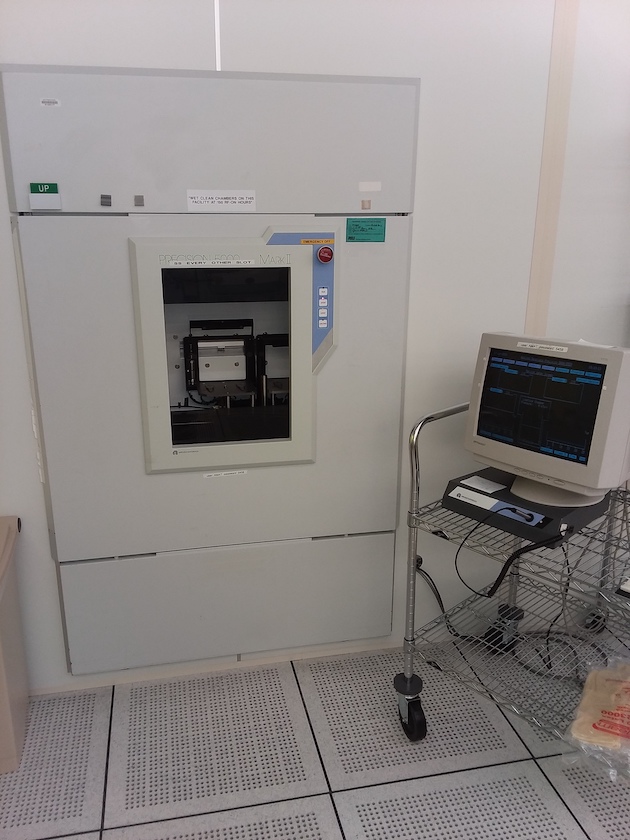The Applied Materials P5000 is a plasma enhanced chemical vapor deposition (PECVD) system designed to deposit thin film dielectrics and doped and undoped silicon, containing semiconductor films deposited by gas sources reacted in a plasma to form a conformal and uniform film. The tool can be used to deposit silicon nitride (SiN), amorphous silicon (a_Si), phosphorous-doped silicon, and boron-doped silicon films. Nitrous oxide (N2O) gas is available, so silicon dioxide (SiO2) could also be deposited.
Plasma enhanced chemical vapor deposition is a chemical deposition technique utilizing reactive gas sources and plasma to produce a conformal thin dielectric or semiconductor film at certain temperatures (400°C maximum for PECVD versus 800°C for pyrolytic chemical vapor deposition). The vacuum chamber is evacuated to below 50 mTorr (6.67 Pa) to minimize atmospheric contaminants before the substrate is introduced into the chamber from the vacuum load lock. A series of lift pins on the chamber susceptor raise and lower to allow the robot to safely place the substrate. The susceptor spacing is then adjusted within a mil (25.4 microns) of the desired susceptor/lid spacing before any process gas is introduced.
The process gases are controlled by a series of pneumatic safety valves and a single mass flow controller (MFC) regulates the mass flow for each individual process gas. The process gas is introduced into the temperature-controlled process chamber where the substrate is resting. A butterfly valve, pendulum valve or other throttling device is used to separately control the internal pressure without the need to adjust the gas flow.
Once all of the process parameters (gas flows, chamber pressure, temperature and susceptor spacing) have stabilized, a radio frequency (RF) generator is turned on. The most common frequency associated with PECVD is the industrial-available 13.56 MHz frequency, although both higher and lower frequencies have been used. The RF signal is modulated and tuned to a 50 Ohm matching impedance through a series of variable and fixed capacitors and inductors arranged in an L matching circuit.
Although the plasma is generated from an AC source, a DC self-bias is present due to the blocking capacitor in the matching network. As a result, a possible buildup of electrons may occur at the powered electrode. This DC self-bias is responsible for the directional (i.e. anisotropic) nature of reactive ion etching and can help improve the conformality of PECVD films via ion bombardment planarization. However, most PECVD chambers do not place the substrate on the powered electrode due to the increased film stress the ion bombardment may cause.
Plasma is a state of matter that is similar to a gas which contains ions, free radicals, and molecules. It is most commonly formed when a gas is ionized. The main reactants in the thin film deposition process are highly reactive radicals and ions formed in plasma. The reactant species are adsorbed onto the surface of the substrate, where they react and produce a solid film. The byproduct gas is desorbed and pumped out of the reaction chamber, along with any unused reactant.
- Plasma enhanced chemical vapor deposition
| Service | ASU rate | Nonprofit/other academic rate | Industry/ Private | Notes |
|---|---|---|---|---|
| Equipment use | $44/hour | $58/hour | Please contact AEPCore@asu.edu |



